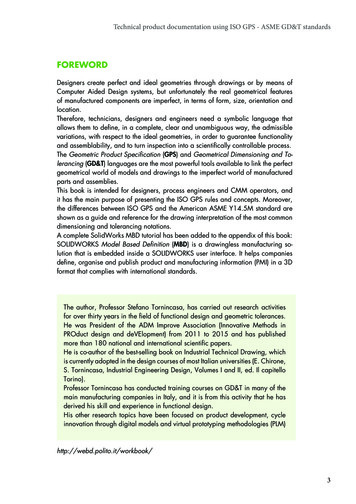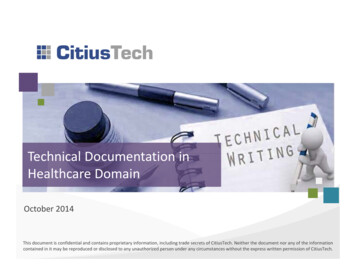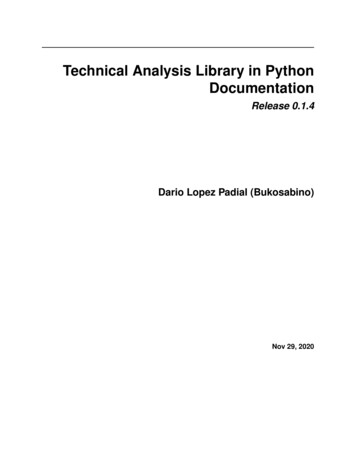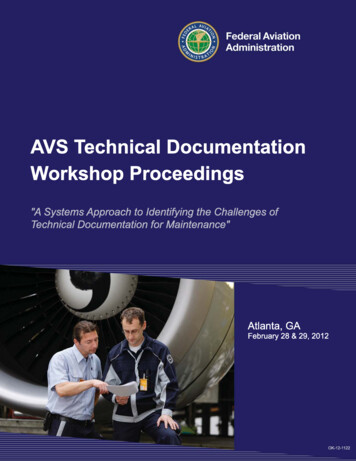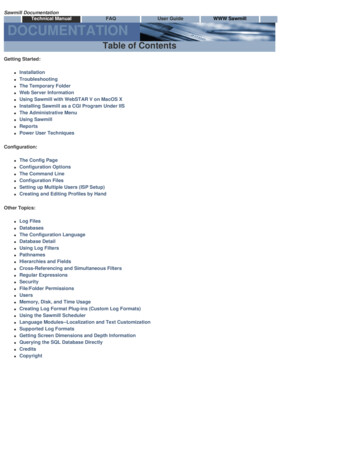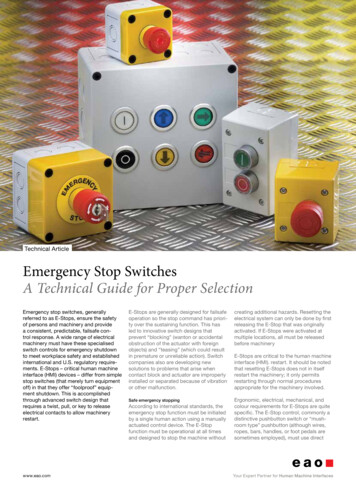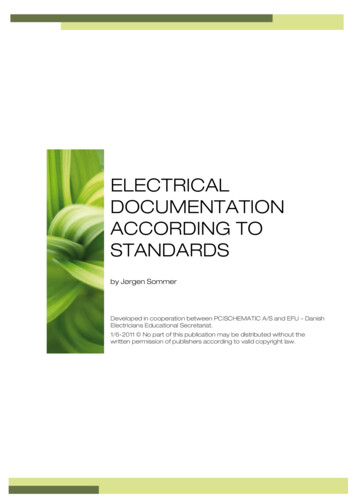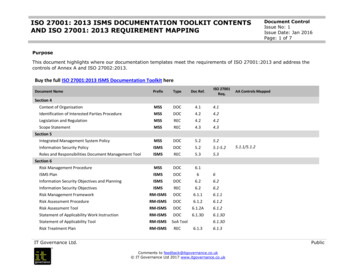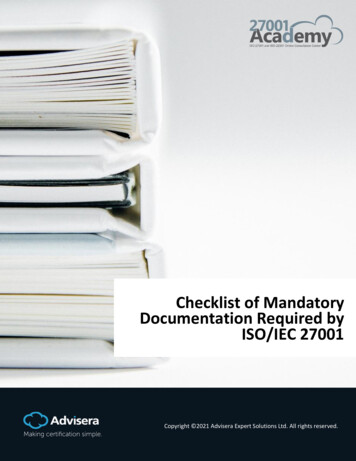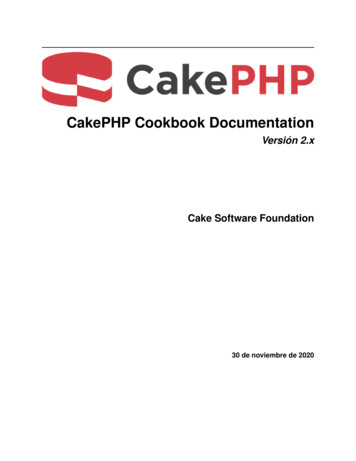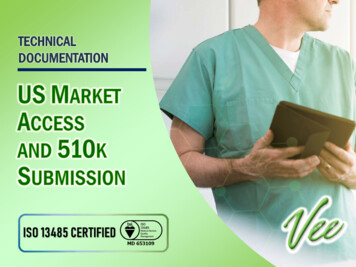
Transcription
TECHNICALDOCUMENTATION1
Regulation Overview WHAT IS PREMARKET NOTIFICATION 510(K)? WHO AND WHEN TO SUBMIT? WHAT IS A PREDICATE DEVICE? How to prepare a traditional 510(k)? HOW TO CLASSIFY YOUR DEVICE? HOW TO FIND A PREDICATE DEVICE? HOW TO LOCATE GUIDANCE AND STANDARDS? What are the content and format of 510(k)?2
3
Each person who wants to market Class I, II andsome III devices intended for human use in theU.S. must submit a 510(k) to FDA at least 90days before marketing unless the device isexempt from 510(k) requirements. There is no 510(k) form but instead a format forthe submission described in 21 CFR 807 A 510(k) is a premarketing submission made toFDA to demonstrate that the device to bemarketed is as safe and effective, that is,substantially equivalent (SE), to a legallymarketed device that is not subject to premarketapproval(PMA).4
Applicants must compare their 510(k) device to one ormore similar devices currently on the U.S. market andmake and support their substantial equivalency claims A legally marketed device is a device that was legallymarketed prior to May 28, 1976 (pre-amendmentsdevice), or a device which has been reclassified fromClass III to Class II or I, a device which has been found tobe substantially equivalent to such a device through the510(k) process, or one established through Evaluation ofAutomatic Class III Definition. The legally marketed device(s) to which equivalence isdrawn is known as the "predicate" device(s).5
510(k) requires demonstration of substantialequivalence. SE means that the new device is assafe and effective as the predicate device(s). A device is SE if, in comparison to a predicate deviceit: HAS THE SAME INTENDED USE AS THE PREDICATE DEVICE; AND HAS THE SAME TECHNOLOGICAL CHARACTERISTICS AS THE PREDICATEDEVICE; OR HAS DIFFERENT TECHNOLOGICAL CHARACTERISTICS, THAT DO NOT RAISENEW QUESTIONS OF SAFETY AND EFFECTIVENESS, AND THE SPONSORDEMONSTRATES THAT THE DEVICE IS AS SAFE AND EFFECTIVE AS THELEGALLY MARKETED DEVICE.6
7
1. Domestic manufacturers introducing a deviceto the U.S. market;2. Specification developers introducing a deviceto the U.S. market;3. Repackers or relabelers who make labelingchanges, or whose operations significantlyaffect the device.4. Foreign manufacturers/exporters or U.S.representatives of foreign manufacturers /exporters introducing a device to the U.S.market.8
1. Introducing a device into commercialdistribution (marketing) for the first time.2. You propose a different intended use for adevice which you already have in commercialdistribution.3. There is a change or modification of a deviceyou already market, if that change couldsignificantly affect its safety or effectiveness.9
10
To find the classification of your device, as well aswhether any exemptions may exist, you need tofind the regulation number that is theclassification regulation for your device. There are two methods for accomplishing this: godirectly to the classification database and searchfor a part of the device name, Or, if you know the device panel (medicalspecialty) to which your device belongs, godirectly to the listing for that panel and identifyyour device and the corresponding regulation.11
12
13
868 ANESTHESIOLOGY870 CARDIOVASCULAR862 CLINICAL CHEMISTRY AND CLINICAL TOXICOLOGY872 DENTAL874 EAR, NOSE, AND THROAT876 GASTROENTEROLOGY AND UROLOGY878 GENERAL AND PLASTIC SURGERY880 GENERAL HOSPITAL AND PERSONAL USE864 HEMATOLOGY AND PATHOLOGY866 IMMUNOLOGY AND MICROBIOLOGY882 NEUROLOGY884 OBSTETRICAL AND GYNECOLOGICAL886 OPHTHALMIC888 ORTHOPEDIC890 PHYSICAL MEDICINE892 RADIOLOGY14
The FDA 510(k) database contains all devicescleared under the 510(k) process. The FDAdatabases on the web are updated on oraround the 5th of every month. The classification of the device and productcode is essential in searching for predicatedevices, which you should already get it whileyou classify your device.15
16
17
FDA has published many device specificguidance documents as well as generalguidance for biocompatibility, softwarecontained in medical device, electromagneticcompatibility, etc. These documents are available through theGuidance Document database.18
andGuidance/GuidanceDocuments/default.htm19
20
21
cfStandards/search.cfm22
Standards historically have had a significant role in addressinginformation needs for substantial equivalence determinations. During the evaluation of 510(k), Information in a 510(k) abouta device’s conformity with a standard has helped characterizethe device and has substituted for detailed descriptiveinformation or performance data. This approach has been used successfully to streamline many510(k) submissions and to reduce the resources required forODE’s reviews, while providing a sound basis for substantialequivalence determination. In case where standards better reflected the current state-ofart than per-1976 predicate devices, this approach hasprovided a greater assurance of safety and effectiveness thancomparisons to predicate device.23
1. Non Invasive Blood Pressure Meter 510(K) FOR NONINVASIVE BLOOD PRESSURE MEASUREMENT SYSTEMSTYPICALLY INCLUDE PERFORMANCE TESTING DATA BECAUSE DESCRIPTIVECHARACTERISTICS ALONE MAY NOT BE PRECISE ENOUGH TO ENSUREEQUIVALENCE. RATHER THAN ALWAYS REQUIRING DATA FROM COMPARATIVE TESTING OF THENEW DEVICE AND A LEGALLY MARKETED DEVICE, ODE HAS ACCEPTEDINFORMATION ON CONFORMITY WITH THE ANSI/AAMI 80601-2-30STANDARD, WHICH INCLUDES PROVISIONS FOR PERFORMANCE TESTING.2. Electrical Ophthalmic Device 510(K) FOR OPHTHALMIC DEVICES HAVE TRADITIONALLY CHARACTERIZED THEELECTRICAL SAFETY OF A DEVICE IN TERMS OF CONFORMANCE WITHSTANDARDS SUCH AS UL-544 OR IEC 60601-1. ODE HAS ACCEPTED STATEMENTS THAT DEVICES WILL CONFORM TO ONE OFTHESE STANDARDS IN PLACE OF MEASUREMENT DATA.24
25
1. Table of Contents2. 510(k) Cover Letter3. Administrative Document3.1 FDA Form - 35143.2 FDA Form – 36743.3 FDA Form – 38813.4 510(k) Summary3.5 Truthful and Accurate Statement3.6 Financial Declaration4. Device Descriptions4.1 Device Design4.2 Device Specifications4.3 Device Materials4.4 Sterilization & Reuse4.5 Labeling4.6 Software4.7 Risk Management5. Device Performances5-1. Performance Testing5-2. Clinical Testing5-3. Electrical & EMC Safety5-4 Biological Safety & Stability6. Substantial Equivalency6-1 Predicate Device Comparison6-2 Predicate Device Information7. Annex7-1 Screening Checklist for 510(k)Submissions7-2 General Formatting of the 510(k)Submission Checklist7-3: 510(k) Summary Checklist7-4: Labeling Checklist7-5: Specific Guidance DocumentsChecklist(s)26
3-1 CDRH Premarket Review Submission CoverSheet (Form FDA-3514)3-2 Certification of Compliance(Form FDA-3674)3-3 Indications for Use Statement (Form 3881)3-4 510(k) Summary3-5 Truthful and Accurate Statement27
28
29
30
31
32
33
34
35
36
37
Ref: FDA 510k Database38
If you choose to meet the conditions for a 510(k)summary (21 CFR 807.92), it must be in sufficientdetail to provide an understanding of the basis for adetermination of substantial equivalence. If you choose to submit a 510(k) Statement, theregulation requires the specific statement asprovided in 21 CFR 807.93. Anyone may request acopy of the 510(k) [with patient identifiers, tradesecret and confidential information deleted] from theapplicant of record. These written requests must befilled within 30 days.39
40
Prepare a Statement of Indications for Use as a separatepage. The Indications for Use recommended format may be used. The statement should include specific indications, clinicalsettings, define the target population, anatomical sites, etc. This statement must be consistent with your labeling,advertising and instructions for use. Once the review is complete, FDA will include the Indicationsfor Use Statement with the Substantial Equivalence (SE) letterto the applicant and make it available to the public on theInternet.41
510(k) Number (if known): Device Name: 5MP Monochrome LCD Monitor Model: XXXXX Indications For Use: THE XXXX LCD MONITOR IS INTENDED TO BE USED INDISPLAYING AND VIEWING DIGITAL IMAGES FOR REVIEW ANDANALYSIS BY TRAINED MEDICAL PRACTITIONERS.42
All 510(k) submitters must include astatement certifying that all informationsubmitted in the 510(k) is truthful andaccurate and that no material fact has beenomitted. The statement may be included in the 510(k)Cover Letter or may be on a separate pageidentified in the table of contents.43
44
4-1. Device Design4-2. Device Specifications4-3. Device Materials4-4. Sterilization & Reuse4-5. Labeling4-6. Software4-7. Risk Management45
Physical features Trade Name & Model Number of modules Operation mode System or module diagrams Patents46
47
This section should include both a narrativedescription of the device and a physical or technicaldescription. The narrative description of the "new" device shouldinclude the indications for use, principles ofoperation, power source, composition and otherinformation necessary to understand the device. If the 510(k) is for an accessory or component soldto an end-user, describe a typical device with whichthe accessory or component will be used. List allvariations of the "new" device which you intend tomarket.48
The physical description of the "new" device may includelabeled diagrams, photographs or pictures, engineeringdrawings, schematics, etc. These may include all internal and external, assembledand unassembled, interchangeable, etc., parts of thedevice and should address their name and function. In addition, the description should include the length,width, height, diameter, weight, etc., of the device andidentify any parts which are intended for single use. Device specific guidance documents, if available, usuallyprovide extensive information on the level of detail whichshould be included in the specifications list.49
50
Descriptions of the materials used BOMS MSDS For LCD Monitor: THERE ARE NO MATERIALS OR BIOCOMPATIBILITY ISSUESIDENTIFIED IN THIS 510(K) SUBMISSION.51
Illustration: Catheter52
For LCD Monitor: THERE ARE NO STERILIZATION AND/OR REUSE ISSUEIDENTIFIED IN THIS 510(K) SUBMISSION. For other products: PACKAGING:- ISO 11607: 2003:TERMINALLY STERILIZED PRODUCTSPACKAGING FOR STERILIZATION: ISO 11135:1994: STERILIZATIONHEALTH CARE PRODUCTS -- ETHYLENE OXIDEOF SHELF-LIFE: ACCELERATED AGING STUDIES PERFORMEDACCORDING TO THE ARRHENIUS MODEL (Q10).53
Prepare a labeling section to include copiesof all proposed labels, labeling, packageinserts, service manuals, instructions for use,advertising and/or promotional materials Copies of labeling for the predicate device(s)is recommended. Labeling guidance isprovided 4
55
Embedded software guidance: GUIDANCE FOR THE CONTENT OF PREMARKET SUBMISSIONSSOFTWARE CONTAINED IN MEDICAL DEVICESFOR Software Documentation (subject to software class) LEVEL OF CONCERN SOFTWARE DESCRIPTION DEVICE HAZARD ANALYSIS SOFTWARE REQUIREMENTS SPECIFICATION (SRS) ARCHITECTURE DESIGN CHART SOFTWARE DESIGN SPECIFICATION (SDS) TRACEABILITY ANALYSIS SOFTWARE DEVELOPMENT ENVIRONMENT DESCRIPTION VERIFICATION AND VALIDATION DOCUMENTATION REVISION LEVEL HISTORY56
A list and a brief description of the functionsperformed by the software. A description of the manufacturer’s softwaredevelopment methods. A list of hazards related to the functionsperformed by the software, and the means takento mitigate each of these hazards. A description of the software test procedures. A certification by a responsible company officialthat the software information provided in thisnotification is correct, and that the sameprocedures will be used to retest and revalidatethe software when it is revised.57
Follow ISO 14971 concept Covers all aspects including all relevantstandards (not just IEC 60601-1) Clinical justification is the best proof undermany instances.58
1. Risk Management Plan - Table of Contents2. Signatures of the Responsible Personnel for this Risk ManagementPlan3. Document History4. Introduction5. Description of Medical Device and Designation of PerformanceProperties6. Personnel and Responsibilities in the Risk Management Process7. Criteria to Analyze and Evaluate the Acceptability of Risks8. Controlling of the Risk Management Process by the Management9. Flow Chart of the Risk Management Process10.Explanations to the Column Legend of the Risk Management Table11.Designation of Elements of the Risk Management File12.Designation of Elements of the Risk Management Report13.Appendices: EN ISO 14971 Annex E.1; Annex E.2; Annex E.359
Signatures of the Responsible Personnel for thisRisk Management Report Document History Introduction (with reference to the protocol; norepetition of the protocol!) Suitability and effectiveness of the riskmanagement process Adequacy of Criteria to Accept Risks Reports about Damages, Complaints and SideEffects Residual Risks Connected to the Product Summary and Conclusion60
RiskRiskEstimatiEvaluationonRISK ANALYSISRisk ock326ALARPxElectricShock326ALARPHarmRisk eablesequence ofevents /Effects(1) patient(2) OperatorInitiating events andcircumstances / casuses/ Least favorableworking conditions /Fault conditions /foreseeable misuse(3) Bystander(4) Service Engineer(5) EnvironmentHarm for(6) failure mode(5) disposal/scrapping(3) environmental factors(4) cleaning/disinfection/sterilization(2) transport/storage(1) incompleteDate of AssessmentHazard ID
3.1 FDA Form - 3514 3.2 FDA Form – 3674 3.3 FDA Form – 3881 3.4 510(k) Summary 3.5 Truthful and Accurate Statement 3.6 Financial Declaration 4. Device Descriptions 4.1 Device Design 4.2 Device Specifications 4.3 Device Materials 4.4 Sterilization & Reuse 4.5 Labeling 4.6 Software 4.7 Risk Management 26 5. Device Performances 5-1. Performance Testing 5-2. Clinical Testing 5-3. Electrical .

